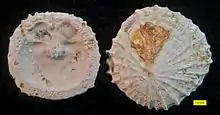Crania (brachiopod)
Crania is an extinct genus of brachiopods that lived during the Upper Cretaceous.
| Crania | |
|---|---|
 | |
| Isocrania costata from the Maastrichtian of the Netherlands. | |
| Scientific classification | |
| Kingdom: | Animalia |
| Clade: | Lophophorata |
| Phylum: | Brachiopoda |
| Class: | Craniata |
| Order: | Craniida |
| Family: | Craniidae |
| Genus: | †Crania Retzius, 1781 |
| Species | |
| |
Description
Crania has small (up to 2 centimetres or 0.79 inches in diameter) circular shells. The dorsal valve is smooth or has slight pustules. The ventral valve is only attached posteriorly and has a thickened flat grainy rim.[1]
Reassigned species
As the genus Crania was erected early on in paleontology, many species have since be reassigned.[1][3]
See also
- List of brachiopod genera
- Taxonomy of commonly fossilised invertebrates
- List of extant animal genera represented in the fossil record
References
- Lee, D. E.; Brunton, C.H.C. (1986). "Neocrania n. gen., and a revision of Cretaceous-Recent brachiopod genera in the family Craniidae". Bulletin of the British Museum (Natural History), Geology Series. 40 (4): 141–160.
- Emig, Christian C. (2009). "Nummulus brattenburgensis and Crania craniolaris (Brachiopoda, Craniidae)". Carnets de Géologie (8). doi:10.4267/2042/29780.
- Moore, R.C. (1965). Brachiopoda. Treatise on Invertebrate Paleontology. Part H., Volume 1. Boulder, Colorado/Lawrence, Kansas: Geological Society of America/University of Kansas Press. pp. H267, H286, H288, H290, H463. ISBN 0-8137-3015-5.
This article is issued from Wikipedia. The text is licensed under Creative Commons - Attribution - Sharealike. Additional terms may apply for the media files.